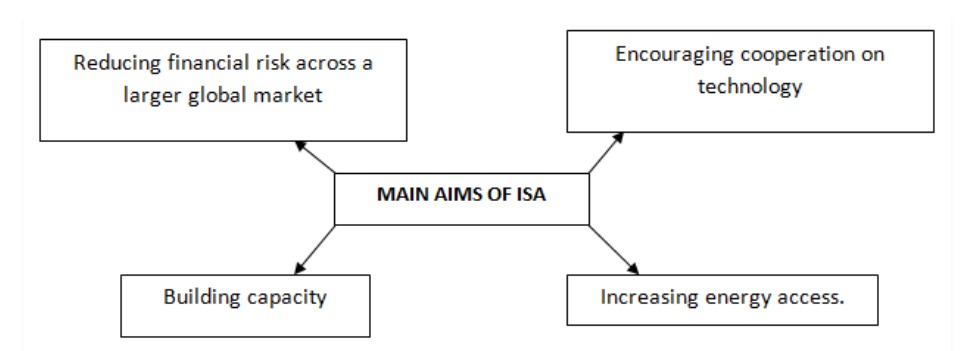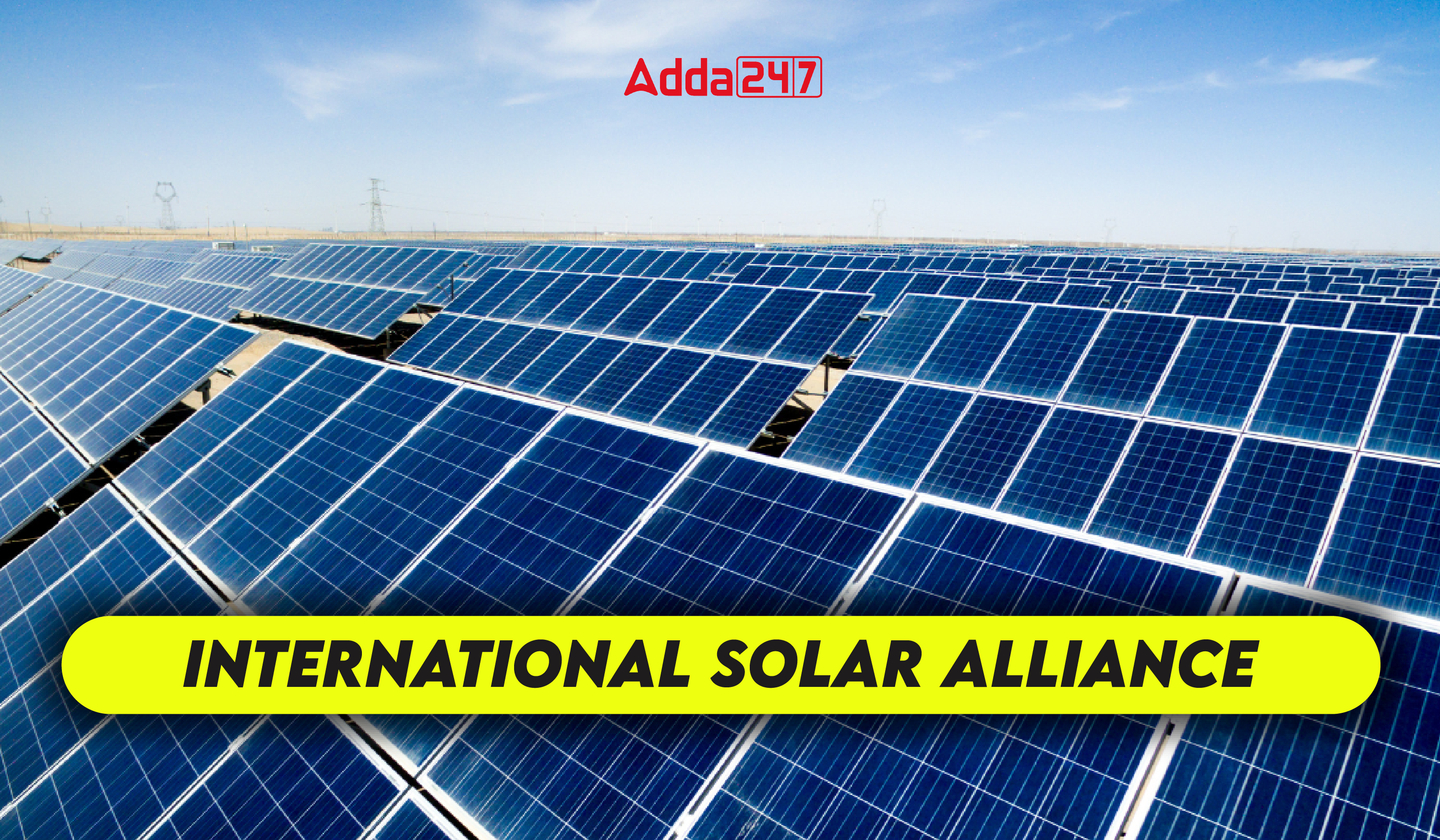Table of Contents
International Solar Alliance, an international intergovernmental organization, was proposed and inaugurated by Indian Prime Minister Narendra Modi and the then President of France, Francois Hollande, at the UN Climate Change Conference. Established on November 30, 2015, in Paris, France, ISA boasts 114 member and signatory countries.
The International Solar Alliance is regarded as an important topic for the UPSC Exam, with a key role in the General Studies paper-1 curriculum covering Geography and the General Studies paper-3 syllabus covering the Environment subject.
Latest update on International Solar Alliance
- The International Solar Alliance released the ‘Ease of Doing Solar Report 2020’ on February 24, 2021.
- ISA is gearing up to launch the World Solar Bank during the UNFCCC COP26 session in 2021.
- India and France were re-elected as President and Co-President of ISA for a two-year term during the virtual third Assembly of ISA.
- The Assembly approved the institutionalization of ISA’s engagement with the private and public corporate sector through the Coalition for Sustainable Climate Action (CSCA).
- Various solar awards were conferred, including the Visvesvaraya award for countries with maximum floating solar capacity, the Kalpana Chawla award for outstanding contribution in solar energy, and the Diwakar award for organizations promoting solar energy and aiding differently-abled individuals.
- ISA launched ISA CARES, akin to India’s PM-CARES, to deploy solar energy in the healthcare sector, aiming to solarize one primary health center per district in target member countries.
- ISA signed a tripartite agreement with the World Bank and the Government of India to prepare a vision and implementation plan for the “One Sun, One World, One Grid” Initiative, facilitating the transition to a low-carbon world through interconnected grids.
International Solar Alliance
India and France start an initiative with the primary goal of promoting the efficient use of solar energy to reduce traditional fossil fuels. This is a collaboration known as the International Solar Alliance (ISA), which was created in 2015. The ISA’s details are as follows.
Aim of International Solar Alliance
- Identifying and addressing significant hurdles hindering the widespread implementation of solar energy technologies.
- Mobilizing substantial financial investments amounting to approximately US $1000 billion by the year 2030.
- Coordinating concerted efforts to foster voluntary initiatives pertaining to solar energy research and development, financing mechanisms, technological innovations, and more.

- Facilitating the provision of financial resources to encourage the adoption of solar energy, thereby reducing the cost of capital associated with such endeavors.
- Promoting the uptake of solar energy solutions among member nations.
- Encouraging the establishment of a collaborative digital platform to facilitate networking, knowledge exchange, and cooperation among stakeholders within the solar energy sector.
Objectives of International Solar Alliance
- The primary goal of the International Solar Alliance (ISA) is to mobilize over USD 1000 billion in investment by 2030 to support the extensive deployment of solar energy.
- ISA aims to enhance the scalability of solar energy and reduce the cost of solar power generation by consolidating demand for solar finance, technologies, innovation, research and development, and capacity building.
- ISA advocates for the utilization of solar energy across various sectors, including Agriculture, Health, Transport, and Power Generation.
- Member countries of ISA are actively contributing to change by formulating policies and regulations, sharing best practices, establishing common standards, and mobilizing investments.
Structure of International Solar Alliance
Candidatesc can check the structure of International Solar Alliance (ISA):
- The ISA Assembly is the top decision-making entity, comprising representatives from all member nations.
- Its responsibilities include ensuring the achievement of ISA objectives, overseeing its operations, approving the operational budget, evaluating program implementation, and assessing overall impact.
- The ISA Secretariat, led by the Director-General appointed for a 4-year term, assists ISA members in implementing programs by offering technical and financial guidance and support.
- Currently, Ajay Mathur IAS holds the position of Director-General.
- India chairs the Standing Committee, with France serving as the co-chair.
Benefits of International Solar Alliance
In the face of global climate change stemming from pollution generated by traditional energy sources like coal, the International Solar Alliance (ISA) emerges as a crucial catalyst for the transition to clean energy.
- The ISA operates a Solar Cyber Centre, accessible 24/7, providing nations with invaluable guidance and information on various projects and financial innovations, fostering global collaboration and knowledge sharing.
- Advocating for financial institutions to allocate a portion of their lending to solar energy mirrors initiatives undertaken by entities like the Reserve Bank of India, prioritizing renewable energy investments as high as 15 crore rupees, with rooftop solar panels eligible for priority sector lending of up to ten lakh rupees.
Benefits for India:
- India stands to emerge as a leader in clean energy among developing nations, capitalizing on its abundant sunshine and asserting itself as a formidable competitor in the international arena, thereby generating potential job opportunities worldwide.
- The ISA’s approach extends beyond national borders, sparking broader discussions and analyses of global energy markets, transcending traditional domestic policy frameworks.
- Despite India’s current limitations in solar energy infrastructure and its commercial viability due to high costs, the ISA can play a pivotal role in funding capacity expansion and driving down costs to achieve its ambitious goal of 100 GW of solar power.
- Furthermore, the ISA serves as a platform for implementing best practices in renewable energy, fostering innovation and efficiency in the sector on a global scale.
India’s Role in International Solar Alliance (ISA)
- India is set to become one of the most significant markets for solar energy, with its domestic strategy aiming to create a capacity of 100 gigawatts, signaling investors and developers.
- The Indian government has pledged to operationalize a solar power capacity of 100 GW by March 2022, which could significantly enhance the country’s energy security.
- The headquarters of the International Solar Alliance will be located in India.
- The ISA’s Interim Secretariat is established at the National Institute of Solar Energy (NISE) in Gwalpahari, Gurgaon.
- India has committed Rs. 100 crores in funding for the ISA.
- Additionally, India will provide 225 crores in secretarial support over the next five years.
- The Indian government is offering training opportunities at NISE for member countries of the ISA, along with funding for demonstration projects such as solar home lighting, solar pumps for farmers, and various other solar applications.
Major Initiatives Under the International Solar Alliance
The International Solar Alliance (ISA) spearheads several major initiatives to promote solar energy adoption globally. One significant effort is the establishment of the World Solar Bank, aimed at financing solar projects and supporting countries with limited resources, Ease of Doing Solar Reports, and ISA’s STAR C program focuses on advancing solar technology and application, aligning with sustainable energy goals outlined in SDG 7 and 13.
Ease of Doing Solar Reports
- Assessments tailored to specific countries gauging their potential for attracting solar investments.
- Aims to identify key barriers and learn from global best practices.
- Evaluation includes factors like macroeconomics, policy environment, and financing costs, following the SDG Goal measurement style.
- Framework developed in collaboration with Ernst and Young LLP.
- Example: India’s 2020 report cites an annual installed solar capacity of 34,831 MW as of 2019, with strong technical feasibility due to ample sunlight.
- Initiatives like the Surya Mitra Skill Development program bolster human resources for the solar PV industry.
- Active involvement of both government and private sectors, particularly through solar park development.
World Solar Bank (WSB)
- ISA to launch the WSB at the 2021 November UN Climate Change Conference in Glasgow.
- Aimed at financing solar home, grid, and pump implementations, with an estimated capital requirement of USD 5.5 billion.
- With COP 26 in Glasgow, ISA seeks to advocate solarization amidst discussions on green financing.
- WSB crucial for supporting financially constrained small countries in the renewable energy sector.
- India’s “One Sun. One World. One Grid” vision focuses on global scaling of solar projects.
ISA STAR C (Solar Technology and Application Resource Center)
- Aimed at achieving national sustainable energy goals, enhancing capacity, and scaling up solar technologies.
- Aligns with SDG 7 and 13, promoting universal access to sustainable energy and combating climate change.
- ISO Infopedia provides comprehensive information on solar power technology, developed with EU assistance, featuring country profiles, a solar information hub, academy, and directory.
- Solinars (Webinars) facilitate capacity development and knowledge sharing among member countries.



 TSPSC Group 1 Question Paper 2024, Downl...
TSPSC Group 1 Question Paper 2024, Downl...
 TSPSC Group 1 Answer key 2024 Out, Downl...
TSPSC Group 1 Answer key 2024 Out, Downl...
 UPSC Prelims 2024 Question Paper, Downlo...
UPSC Prelims 2024 Question Paper, Downlo...





